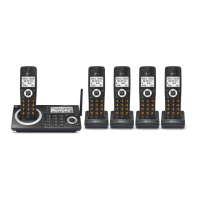112
Appendix
FCC Part 68 and ACTA
Industry Canada
This device contains licence-exempt transmitter(s)/receiver(s) that comply with Innovation, Science
and Economic Development Canada’s licence-exempt RSS(s). Operation is subject to the following two
conditions:
(1) This device may not cause interference.
(2) This device must accept any interference, including interference that may cause undesired
operation of the device.
Privacy of communications may not be ensured when using this telephone.
»¸Ç¸ÅÀÓÔ¢ÓÔµ¸¹ÂŸǻ¸¶¸ÅǼ趴ǼÂÁŸº¼ÆÇŴǼÂÁÁÈÀµ¸ÅÂÁ¿ÌƼºÁ¼è¸ÆÇ»´ÇÇ»¸¢Á·ÈÆÇÅÌ´Á´·´
Ǹ¶»Á¼¶´¿Æø¶¼è¶´Ç¼ÂÁÆʸŸÀ¸Ç
The Ringer Equivalence Number (REN) for this terminal equipment is 1.0. The REN indicates the
maximum number of devices allowed to be connected to a telephone interface. The termination of an
interface may consist of any combination of devices subject only to the requirement that the sum of
Ç»¸«§Æ¹´¿¿Ç»¸·¸É¼¶¸ÆÁÂǸ˶¸¸·èɸ
This product meets the applicable Innovation, Science and Economic Development Canada technical
Æø¶¼è¶´Ç¼ÂÁÆ
FCC Part 15
NOTE: This equipment has been tested and found to comply with the requirements for a Class B digital
device under Part 15 of the Federal Communications Commission (FCC) rules. These requirements are
intended to provide reasonable protection against harmful interference in a residential installation.
This equipment generates, uses and can radiate radio frequency energy and, if not installed and used in
accordance with the instructions, may cause harmful interference to radio communications. However,
there is no guarantee that interference will not occur in a particular installation. If this equipment does
cause harmful interference to radio or television reception, which can be determined by turning the
¸ÄȼÃÀ¸ÁÇÂæ´Á·ÂÁÇ»¸ÈƸżƸÁ¶ÂÈÅ´º¸·ÇÂÇÅÌǶÂÅŸ¶ÇÇ»¸¼ÁǸŹ¸Å¸Á¶¸µÌÂÁ¸ÂÅÀŸ¹ǻ¸
following measures:
f Reorient or relocate the receiving antenna.
f Increase the separation between the equipment and receiver.
f ÂÁÁ¸¶ÇÇ»¸¸ÄȼÃÀ¸ÁǼÁÇ´ÁÂÈÇ¿¸ÇÂÁ´¶¼Å¶È¼Ç·¼æ¸Å¸ÁǹÅÂÀÇ»´ÇÇÂÊ»¼¶»Ç»¸Å¸¶¸¼É¸Å
is connected.
f Consult the dealer or an experienced radio/TV technician for help.
°«§¢§»´Áº¸ÆÂÅÀ·¼è¶´Ç¼ÂÁÆÇÂÇ»¼Æ¸ÄȼÃÀ¸ÁÇÁÂǸËßÆÆ¿Ì´ÃÃÅÂɸ·µÌÇ»¸Ã´ÅÇÌ
responsible for compliance could void the user’s authority to operate the equipment.
This device complies with Part 15 of the FCC Rules. Operation is subject to the following two conditions:
(1) this device may not cause harmful interference, and (2) this device must accept any interference
received, including interference that may cause undesired operation. Privacy of communications may
not be ensured when using this telephone.
To ensure safety of users, the FCC has established criteria for the amount of radio frequency energy
that can be safely absorbed by a user or bystander according to the intended usage of the product.
This product has been tested and found to comply with the FCC criteria. The handset may be safely
held against the ear of the user. The telephone base shall be installed and used such that parts of the
user’s body other than the hands are maintained at a distance of approximately 20 cm
(8 inches) or more.
This Class B digital apparatus complies with Canadian requirement:
CAN ICES-3 (B)/NMB-3(B)

